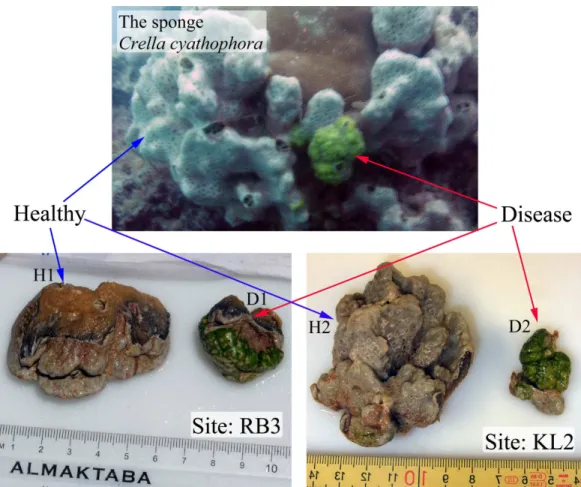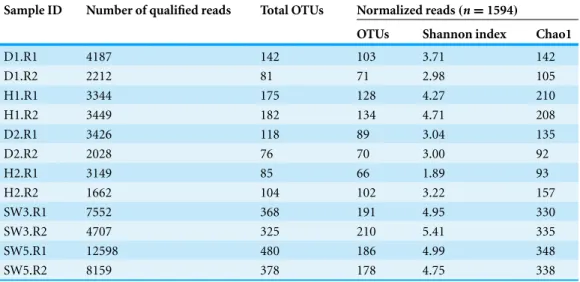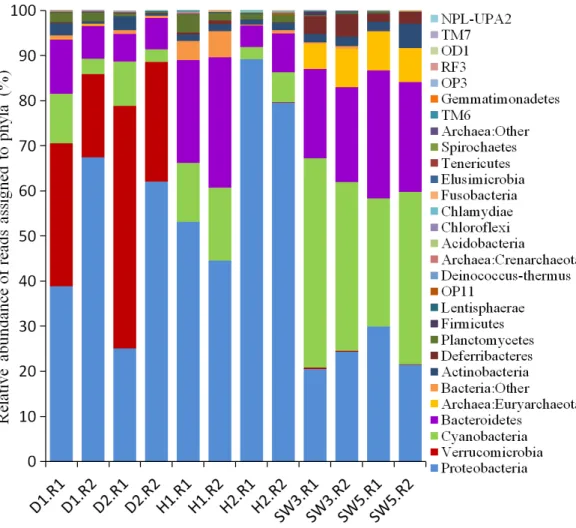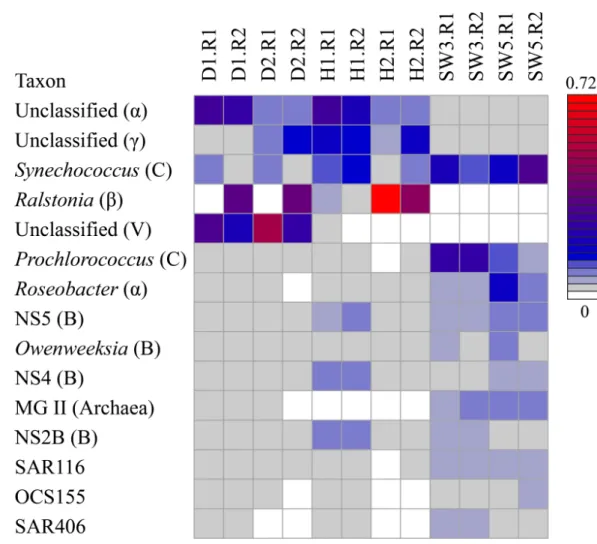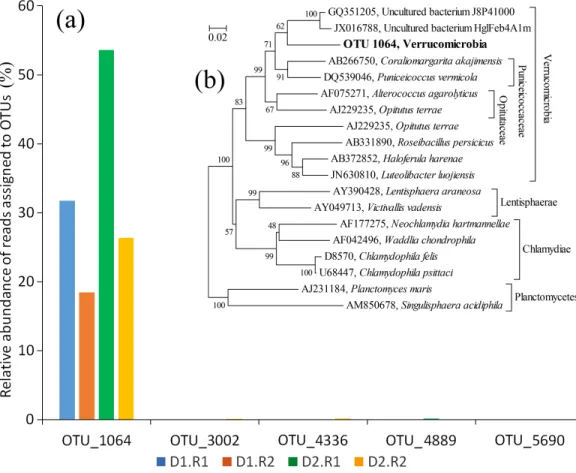Submitted 30 November 2014 Accepted 23 March 2015 Published11 June 2015
Corresponding author Pei-Yuan Qian, boqianpy@ust.hk
Academic editor Hauke Smidt
Additional Information and Declarations can be found on page 10
DOI10.7717/peerj.890
Copyright 2015 Gao et al.
Distributed under
Creative Commons CC-BY 4.0
OPEN ACCESS
Pyrosequencing revealed shifts of
prokaryotic communities between
healthy and disease-like tissues of the Red
Sea sponge
Crella cyathophora
Zhao-Ming Gao1,2, Yong Wang1,2, Ren-Mao Tian1, On On Lee1, Yue Him Wong1, Zenon B. Batang3, Abdulaziz Al-Suwailem3, Feras F. Lafi4, Vladimir B. Bajic4and Pei-Yuan Qian1
1Division of Life Science, The Hong Kong University of Science and Technology, Clear Water Bay,
Hong Kong, PR China
2Sanya Institute of Deep Sea Science and Engineering, Chinese Academy of Sciences, Sanya,
Hai Nan, PR China
3Coastal and Marine Resources Core Lab, King Abdullah University of Science and Technology
(KAUST), Thuwal, Saudi Arabia
4Computational Bioscience Research Center (CBRC), King Abdullah University of Science and
Technology (KAUST), Thuwal, Saudi Arabia
ABSTRACT
Sponge diseases have been widely reported, yet the causal factors and major pathogenic microbes remain elusive. In this study, two individuals of the sponge
Crella cyathophorain total that showed similar disease-like characteristics were collected from two different locations along the Red Sea coast separated by more than 30 kilometers. The disease-like parts of the two individuals were both covered by green surfaces, and the body size was much smaller compared with adjacent healthy regions. Here, using high-throughput pyrosequencing technology, we investigated the prokaryotic communities in healthy and disease-like sponge tissues as well as adjacent seawater. Microbes in healthy tissues belonged mainly to the Proteobacteria, Cyanobacteria and Bacteroidetes, and were much more diverse at the phylum level than reported previously. Interestingly, the disease-like tissues from the two sponge individuals underwent shifts of prokaryotic communities and were both enriched with a novel clade affiliated with the phylum Verrucomicrobia, implying its intimate connection with the disease-like Red Sea spongeC. cyathophora. Enrichment of the phylum Verrucomicrobia was also considered to be correlated with the presence of algae assemblages forming the green surface of the disease-like sponge tissues. This finding represents an interesting case of sponge disease and is valuable for further study.
Subjects Biodiversity, Ecology, Environmental Sciences, Marine Biology, Microbiology
Keywords Low microbial abundance, Verrucomicrobia, Sponge symbiont, Disease-like sponge
INTRODUCTION
dense and diverse microbial communities of ecological and biotechnological importance (Taylor et al., 2007). Reports have shown that microbes can constitute up to 60% of the sponge tissue volume (Hentschel et al., 2003). In recent years, pyrosequencing technology has facilitated environmental microbial research and increased our knowledge concerning sponge-associated microbial diversity (Webster & Taylor, 2012). According to a recent study, up to 32 bacterial phyla and candidate phyla were documented in sponges (Schmitt et al., 2012). The sponge-species and sampling location specificity of sponge-associated microbes were also described (Lee et al., 2011;Webster et al., 2013). In addition, sponges can be grouped into high microbial abundance (HMA; previously called bacteriosponges) and low microbial abundance (LMA) sponges based on the density of microbes in the host (Hentschel et al., 2003).
An increasing number of reports have demonstrated that sponges are being threatened by disease and mortality events, most of which are accounted for increases of seawater temperature, global climate change and other independent prevailing environmental conditions (Wulff, 2006;Webster et al., 2008;Simister et al., 2012). Shifts of microbial community structures have been observed in diseased sponges (Angermeier et al., 2012;
Gao et al., 2014). Microorganisms including Cyanobacteria, fungi, viruses, Alphapro-teobacteria, and representatives of the generaBacillusandPseudomonasare considered potential pathogens that cause sponge disease (Webster, 2007). However, determining the causative agent of sponge diseases is difficult. Only one pathogen belonging to the Alphaproteobacteria and infecting the Great Barrier Reef spongeRhopaloeides odorabile
has been identified to date (Webster et al., 2002). Other studies have failed to establish a disease-like syndrome in healthy sponges using infection assays failed (Angermeier et al., 2011), and the roles of microbes on sponge disease remain inconclusive.
Crella cyathophorais a LMA sponge species, and its bacterial communities have been reported to be dominated by Proteobacteria (Giles et al., 2013). Here, two individuals of the LMA spongeC.cyathophorawith similar disease-like characteristics were found at two different locations in Saudi Arabia along the Red Sea coast. The disease-like parts of the two individuals were both covered by green surfaces, and the body size was much smaller than adjacent healthy parts of the sponge (Fig. 1). Healthy and disease-like tissues of the two sponge individuals as well as adjacent seawater were collected and 16S rRNA genes were amplified. Using pyrosequencing of tagged 16S rRNA amplicons, shifts of prokaryotic communities in these disease-like individuals were investigated and enriched microbes in the disease-like tissues were elucidated.
MATERIAL AND METHODS
Sample collection and DNA extraction
Figure 1 Healthy and abnormal tissues of the sponge Crella cyathophora.Sample IDs are referred to
Table 1.
Table 1 Tissue samples of the spongeCrella cyathophoraand adjacent seawater.Samples were col-lected from the Rabigh Bay (RB) and Al Kharar Lagoon (KL) along the Red Sea coast.
Site Coordinate Depth (m) Sample ID Description
RB3 22◦42′38′′N ∼9.5 D1 Abnormal tissue (green surface) from individual 1
38◦59′47′′E H1 Healthy tissue (white surface) from individual 1
SW3 Sea water from the site RB3
KL2 22◦57′39′′N ∼2.75 D2 Abnormal tissue (green surface) from individual 2
38◦49′30′′E H2 Healthy tissue (white surface) from individual 2
SW5 Sea water from the site KL2
2×0.5 mL for DNA extraction, which was used as two technical replicates, was dissected,
cut into small pieces with a sterile razor blade, and frozen in 0.8 mL of extraction buffer (100 mM Tris–HCl, 100 mM EDTA, 100 mM Na2HPO4, 1.5 M NaCl, 1% CTAB, pH
8.0). 2×1 L of each seawater sample, used as two replicates, were filtered sequentially
through two membranes: the first was a 1.6-µm-pore-sized glass fiber membrane (GF/A, diameter 125 mm; Whatman, Little Chalfont, UK) to remove suspended particles and eukaryotes; the second was a 0.22-µm polycarbonate membrane to capture microbial cells (polycarbonate, 47 mm in diameter; Millipore, Billerca, Massachusetts, USA). The latter polycarbonate membranes were then frozen in 0.8 mL of extraction buffer for DNA extraction. Total genomic DNA was extracted using the modified sodium dodecyl sulfate-based method described previously (Lee et al., 2011), and further purified with the Mo Bio Soil DNA Isolation Kit (Mo Bio Laboratories, Carlsbad, California, USA). The purified DNA samples were subjected to a NanoDrop ND-100 device for quantification (Thermo Fisher, Waltham, Massachusetts, USA), and then were stored at−20◦C until use.
PCR amplification of 16S rRNA genes and 454 pyrosequencing
The V5-V9 regions of bacterial and archaeal 16S rRNA genes were amplified by PCR using the universal primers U905F TGAAACTYAAAGGAATTG-3’) and U1492R (5’-GGTTACCTTGTTACGACTT-3’) (Leser et al., 2002;Wang & Qian, 2009). Eight-nucleotide barcodes for distinguishing sponge samples were added at the terminal of primers. A 50-µl PCR reaction volume consisted of 2.5 U of Pfu Turbo DNA polymerase (Stratagene, La Jolla, CA, USA), 1×Pfu reaction buffer, 0.2 mM of dNTPs (TaKaRa, Dalian, China),
0.1µM of each pair of barcoded primers and 5–10 ng of genomic DNA template. PCR was performed using a thermal cycler (Bio-Rad, Hercules, California, USA) with the following conditions: initial denaturation at 94◦C for 5 min; 30 cycles of denaturation at 94◦C for 40 s, annealing at 50◦C for 40 s and extension at 72◦C for 60 s; and a final extension at 72◦C for 5 min. PCR products were quantified using the NanoDrop device, mixed equally and subjected to the ROCHE 454 FLX Titanium platform (Roche, Basel, Switzerland) for 454 pyrosequencing. 18S rRNA genes of kinds of Eukaryotes were also amplified using the same primer pair and following the above procedure.
Processing of sequencing data
the SILVA 111 database with PyNAST (Caporaso et al., 2010a). The aligned sequences were searched for chimeras using ChimeraSlayer (Haas et al., 2011). Non-chimeric representatives were assigned taxonomically using the Ribosomal Database Project (RDP) classifier version 2.2 (Wang et al., 2007) against the SILVA111 database (Pruesse et al., 2007) with a confidence threshold of 0.5. Sequences that were annotated as chloroplast, mitochondria and eukaryotes were filtered out. Taxonomic abundance of reads in each sample was summarized at the phylum, class, order, family and genus levels. Species diversity, Shannon index, richness and rarefaction curves were calculated using the QIIME alpha diversity pipeline with a step size of 100 and 100 repetitions per step. Using the above mentioned primer pair, partial eukaryotic 18S rRNA genes were also successfully amplified and included in the pyrosequencing reads. They were separately summarized to reveal the relative abundance of Eukaryotes in the sponge samples.
16S rRNA phylogenetic tree construction
A predominant OTU assigned to the phylum Verrucomicrobia was imported into “The All-Species Living Tree” Project LTPs 115 tree (Yarza et al., 2008) and 16S rRNA sequences of the closest representative species were obtained. The OTU was further searched against the NCBI GenBank database using the BLASTn program to find closely related sequences. A neighbour-joining tree was constructed using MEGA5.1 software (Tamura et al., 2011). Multiple alignment was performed using ClustalW (Thompson, Higgins & Gibson, 1994). Distance matrices were calculated using Kimura’s two-parameter correction model (Kimura, 1980). Bootstrap values were determined with 1000 replications.
RESULTS AND DISCUSSION
Diversity of sponge-associated prokaryotic communities
Two sponge individuals of the spongeC. cyathophorawere collected, and two technical replicates of healthy and disease-like tissues were cut offfrom each individuals. Together with the surrounding seawater of each sampling site, a total of 12 DNA samples were obtained (Table 2). Their 16S rRNA gene amplicons were subjected to pyrosequencing. After quality filtering, 56,473 reads with an average length of 549 bp were obtained. Total number of prokaryotic OTUs in healthy sponge tissues ranged from 85 to 182, and that in disease-like tissues ranged from 76 to 142. The total number of prokaryotic OTUs was close to the number of Chao-based estimations of species richness (Table 2). Together with rarefaction curves based on observed species (OTUs, drawn using the QIIME alpha diversity pipeline at a 3% dissimilarity), the sequencing depth for all of the sponge samples was indicated to be representative, but the number of reads in seawater samples was still insufficient (Fig. S1).
The number of OTUs, Shannon index, and Chao1 estimation of species richness based on normalized reads(n=1594)showed that the microbial diversity of healthy sponge
Table 2 Pyrosequencing summary of microbial communities in sponges and seawater.OTUs, Shan-non index and Chao1 were determined at 3% dissimilarity. Refer toTable 1for sample IDs. ‘R1’ and ‘R2’ denote technical replicates 1 and 2, respectively.
Sample ID Number of qualified reads Total OTUs Normalized reads(n=1594)
OTUs Shannon index Chao1
D1.R1 4187 142 103 3.71 142
D1.R2 2212 81 71 2.98 105
H1.R1 3344 175 128 4.27 210
H1.R2 3449 182 134 4.71 208
D2.R1 3426 118 89 3.04 135
D2.R2 2028 76 70 3.00 92
H2.R1 3149 85 66 1.89 93
H2.R2 1662 104 102 3.22 157
SW3.R1 7552 368 191 4.95 330
SW3.R2 4707 325 210 5.41 335
SW5.R1 12598 480 186 4.99 348
SW5.R2 8159 378 178 4.75 338
obvious divergence of microbial diversity was observed between healthy and disease-like sponge tissues.
Taxonomic assignment of prokaryotic pyrosequencing reads at the phylum level
Taxonomic assignment of pyrosequencing reads at the phylum level provided insights into the shifts of prokaryotic communities in disease-like sponge tissues (Fig. 2). Healthy tissues of the spongeC. cyathophorawere mainly composed of Proteobacteria, Cyanobacteria and Bacteroidetes. Archaea that accounted for a considerable proportion of the prokaryotic community of the surrounding seawater were rarely detected in the sponge samples, which was consistent with a previous report byGiles et al. (2013). The report also demonstrated a low phylum-level microbial diversity in the spongeC. cyathophorawith up to only five bacterial phyla could be detected. However, using high-throughput pyrosequencing technology, we showed herein that phylum-level microbial diversity in healthy sponge tissues was higher than that reported previously, although the number of phyla that accounted for an abundance of higher than 1% of each sample was no more five (Fig. S2). In all of the disease-like sponge tissues, an additional phylum Verrucomicrobia was enriched and became predominant. The predominance of the same novel phylum in two disease-like sponge individuals collected from different locations (Table 1) should not be separated occasional events, and there should be an identical factor influencing both the two individuals.
Taxonomic assignment of prokaryotic pyrosequencing reads at the genus level
Figure 2 Taxonomic classification of microbial reads in sponges and seawater at the phylum level. Mi-crobial reads were assigned taxonomically using the RDP classifier against the SILVA 111 database with a confidence threshold of 50%. Sample IDs are referred toTables 1and2.
one sample was depicted in a heatmap (Fig. 3). Unclassified Alphaproteobacteria and Gammaproteobacteria showed a high abundance in healthy sponge tissues as well as in several disease-like tissues, yet they were rarely found in surrounding seawater. Unclassified Alphaproteobacteria and Gammaproteobacteria also have been reported to be dominant in the spongeC. cyathophoraaccording to a previous study (Giles et al., 2013), which implied that these uncultured bacteria are key sponge-associated components. LMA sponges were reported to share more microbes with surrounding seawater than HMA sponges (Moitinho-Silva et al., 2014). The genusSynechococcus, which was highly abundant in surrounding water, could also be found in several healthy and disease-like sponge samples. Alternatively, there was a random abundance pattern of the genusRalstonia
Figure 3 Heatmap showing the abundance of microbial reads in disease-like and healthy sponge tissues and in adjacent seawater at the genus level.Genera that showed less than 5% abundance in all the samples were filtered out. Sample IDs are referred to Tables 1 and 2. Abbreviations: α, Al-phaproteobacteria;β, Betaproteobacteria;γ, Gammaproteobacteria; C, Cyanobacteria; B, Bacteroidetes; V, Verrucomicrobia.
were only found in the endosome of the spongeTethya aurantium(Thiel et al., 2007). Our study focused on the ectoderm of the spongeC. cyathophora, but some samples have also included endosome tissues, which maybe the reason causing the large difference between disease-like technical replicates.Ralstoniais usually heterotrophic and rarely reported in sponge-associated microbial communities. Detection of the genusRalstoniain the sponge
C. cyathophorais curious, but it may represent a novel sponge-associated bacterium that was overlooked in other sponge-related studies.
Figure 4 The abundance of OTUs affiliated with the phylum Verrucomicrobia and the phylogenetic relationship of OTU 1064.(A), proportions of the OTUs in disease-like tissues of the spongeCrella cyathophora; (B), the phylogenetic relationship of OTU 1064 with representative species in the LTPs 115 tree and uncultured clones in the NCBI GenBank NR database. The tree was constructed based on the neighbor-joining method. Values are expressed based on 1000 replications. Bar, 0.02% estimated sequences divergence.
identified species. A BLASTn search further showed that OTU 1064 shared less than 90% identity with all of the sequences stored in the GenBank NR database. This finding suggested the presence of a novel verrucomicrobial clade with a function that cannot be predicted based on its close relatives. Enrichment of this novel clade implied its intimate connection with the disease-like sponge tissues and likely represents a pathogen infecting the disease-like sponge tissues. However, there is also the possibility that the potential disease attracted this novel bacterium into the sponge tissues. The two disease-like sponge individuals were both covered with a green surface, which might be assemblages of algae. There is a large possibility that this novel Verrucomicrobia clade correlated with the assumed algal assemblages. We also identified 18S rRNA gene sequences of green algae affiliated with the class Prasinophyceae (Table S1), although it still could not be sure whether these are the assumed algal assemblages.
dominated the eukaryotic communities of the sponge samples (Table S1), and were potentially related to the green assemblages. Yet, it still could not be sure whether these are the assumed algal assemblages because Prasinophyceae appeared both in healthy and diseased-like sponges tissues.
CONCLUSIONS
Here, using high throughput pyrosequencing technology, we re-analyzed the prokaryotic communities of this sponge species and their shifts in disease-like tissues. Healthy tissues showed a low microbial diversity and were dominated by Proteobacteria, as reported previously (Giles et al., 2013). Disease-like tissues from two sponge individuals underwent shifts of prokaryotic communities, and both showed enrichment for a novel verrucomicrobial clade. Because there were only two individuals, the extent of the disease spreading could not be evaluated. However, the finding of disease-like sponges at two distinct locations was interesting. The occurrence of a novel verrucomicrobial clade in the disease-like sponge tissues with a small body size and covered by green surfaces certainly indicated an intimate relationship between this novel clade and the disease-like Red Sea spongeC. cyathophora. Collecting more biological sponge replicates that display this disease-like phenomenon from different locations of the Red Sea is required to re-assess the prevalence of this novel verrucomicrobial clade. In addition, further studies are also needed to uncover the source of the novel verrucomicrobial clade and its ascertained roles in disease-like sponges.
ACKNOWLEDGEMENTS
We thank WP Zhang and G Zhang from Hong Kong University of Science and Technology (HKUST), and the technical team from King Abdullah University of Science and Technology (KAUST) for their assistance during sample collection. We also thank Professor Rob von Soest, Zoological Museum, University of Amsterdam, for identification of sponges.
ADDITIONAL INFORMATION AND DECLARATIONS
Funding
This study was supported by the Strategic Priority Research Program of the Chinese Academy of Sciences (No. XDB06010102 and XDB06010201), SKLMP Seed Collaborative Research fund (CITYU12SC01), and an award (SA-C0040/UK-C0016) granted to PY Qian from the King Abdullah University of Science and Technology. The funders had no role in study design, data collection and analysis, decision to publish, or preparation of the manuscript.
Grant Disclosures
The following grant information was disclosed by the authors:
SKLMP Seed Collaborative Research: CITYU12SC01.
King Abdullah University of Science and Technology: SA-C0040/UK-C0016.
Competing Interests
The authors declare there are no competing interests.
Author Contributions
• Zhao-Ming Gao conceived and designed the experiments, performed the experiments,
analyzed the data, wrote the paper, prepared figures and/or tables.
• Yong Wang wrote the paper, reviewed drafts of the paper.
• Ren-Mao Tian performed the experiments, contributed reagents/materials/analysis
tools.
• On On Lee, Yue Him Wong and Zenon B. Batang contributed
reagents/materials/analysis tools.
• Abdulaziz Al-Suwailem and Feras F. Lafi reviewed drafts of the paper.
• Vladimir B. Bajic and Pei-Yuan Qian conceived and designed the experiments, reviewed
drafts of the paper.
DNA Deposition
The following information was supplied regarding the deposition of DNA sequences: Raw pyrosequencing data were submitted to the NCBI Sequence Read Archive under accession numberSRA065210.
Supplemental Information
Supplemental information for this article can be found online athttp://dx.doi.org/ 10.7717/peerj.890#supplemental-information.
REFERENCES
Angermeier H, Glockner V, Pawlik JR, Lindquist NL, Hentschel U. 2012.Sponge white patch disease affecting the Caribbean sponge Amphimedon compressa.Diseases of Aquatic Organisms
99:95–102DOI 10.3354/dao02460.
Angermeier H, Kamke J, Abdelmohsen UR, Krohne G, Pawlik JR, Lindquist NL, Hentschel U. 2011.The pathology of sponge orange band disease affecting the Caribbean barrel sponge Xestospongia muta.FEMS Microbiology Ecology75:218–230
DOI 10.1111/j.1574-6941.2010.01001.x.
Caporaso JG, Bittinger K, Bushman FD, DeSantis TZ, Andersen GL, Knight R. 2010a.PyNAST: a flexible tool for aligning sequences to a template alignment.Bioinformatics26:266–267
DOI 10.1093/bioinformatics/btp636.
Caporaso JG, Kuczynski J, Stombaugh J, Bittinger K, Bushman FD, Costello EK, Fierer N, Pe˜na AG, Goodrich JK, Gordon JI, Huttley GA, Kelley ST, Knights D, Koenig JE, Ley RE, Lozupone CA, McDonald D, Muegge BD, Pirrung M, Reeder J, Sevinsky JR, Turnbaugh PJ, Walters WA, Widmann J, Yatsunenko T, Zaneveld J, Knight R. 2010b.QIIME allows analysis of high-throughput community sequencing data.Nature Methods7:335–336
Edgar RC. 2010.Search and clustering orders of magnitude faster than BLAST.Bioinformatics
26:2460–2461DOI 10.1093/bioinformatics/btq461.
Gao ZM, Wang Y, Lee OO, Tian RM, Wong YH, Bougouffa S, Batang Z, Al-Suwailem A, Lafi FF, Bajic VB, Qian PY. 2014.Pyrosequencing reveals the microbial communities in the red sea sponge carteriospongia foliascens and their impressive shifts in abnormal tissues.Microbial Ecology68:621–632DOI 10.1007/s00248-014-0419-0.
Giles EC, Kamke J, Moitinho-Silva L, Taylor MW, Hentschel U, Ravasi T, Schmitt S. 2013.
Bacterial community profiles in low microbial abundance sponges.FEMS Microbiology Ecology
83:232–241DOI 10.1111/j.1574-6941.2012.01467.x.
Haas BJ, Gevers D, Earl AM, Feldgarden M, Ward DV, Giannoukos G, Ciulla D, Tabbaa D, Highlander SK, Sodergren E, Meth´e B, DeSantis TZ, Human Microbiome Consortium, Petrosino JF, Knight R, Birren BW. 2011.Chimeric 16S rRNA sequence formation and detection in Sanger and 454-pyrosequenced PCR amplicons.Genome Research21:494–504
DOI 10.1101/gr.112730.110.
Hedges SB, Blair JE, Venturi ML, Shoe JL. 2004. A molecular timescale of eukaryote evolution and the rise of complex multicellular life. BMC Evolutionary Biology
4:2DOI 10.1186/1471-2148-4-2.
Hentschel U, Fieseler L, Wehrl M, Gernert C, Steinert M, Hacker J, Horn M. 2003.Microbial diversity of marine sponges. In: M¨uller WEG, ed.Sponges (Porifera). Heidelberg: Springer, 59–83.
Kimura M. 1980.A simple method for estimating evolutionary rates of base substitutions through comparative studies of nucleotide sequences.Journal of Molecular Evolution16:111–120
DOI 10.1007/BF01731581.
Lee OO, Wang Y, Yang JK, Lafi FF, Al-Suwailem A, Qian PY. 2011.Pyrosequencing reveals highly diverse and species-specific microbial communities in sponges from the Red Sea.The ISME Journal: Multidisciplinary Journal of Microbial Ecology5:650–664DOI 10.1038/ismej.2010.165.
Leser TD, Amenuvor JZ, Jensen TK, Lindecrona RH, Boye M, Moller K. 2002.
Culture-independent analysis of gut bacteria: the pig gastrointestinal tract microbiota revisited.Applied and Environmental Microbiology68:673–690DOI 10.1128/AEM.68.2.673-690.2002.
Moitinho-Silva L, Bayer K, Cannistraci CV, Giles EC, Ryu T, Seridi L, Ravasi T, Hentschel U. 2014.Specificity and transcriptional activity of microbiota associated with low and high microbial abundance sponges from the Red Sea.Molecular Ecology 23:1348–1363
DOI 10.1111/mec.12365.
Pruesse E, Quast C, Knittel K, Fuchs BM, Ludwig W, Peplies J, Glockner FO. 2007.SILVA: a comprehensive online resource for quality checked and aligned ribosomal RNA sequence data compatible with ARB.Nucleic Acids Research35:7188–7196DOI 10.1093/nar/gkm864.
Reeder J, Knight R. 2010.Rapidly denoising pyrosequencing amplicon reads by exploiting rank-abundance distributions.Nature Methods7:668–669DOI 10.1038/nmeth0910-668b.
Schmitt S, Tsai P, Bell J, Fromont J, Ilan M, Lindquist N, Perez T, Rodrigo A, Schupp PJ, Vacelet J, Webster N, Hentschel U, Taylor MW. 2012. Assessing the complex sponge microbiota: core, variable and species-specific bacterial communities in marine sponges. The ISME Journal: Multidisciplinary Journal of Microbial Ecology6:564–576
DOI 10.1038/ismej.2011.116.
Simister R, Taylo MW, Tsai P, Fan L, Bruxner TJ, Crowe ML, Webster N. 2012.Thermal stress responses in the bacterial biosphere of the Great Barrier Reef sponge, Rhopaloeides odorabile.
Tamura K, Peterson D, Peterson N, Stecher G, Nei M, Kumar S. 2011.MEGA5: molecular evolutionary genetics analysis using maximum likelihood, evolutionary distance, and maximum parsimony methods.Molecular Biology and Evolution 28:2731–2739
DOI 10.1093/molbev/msr121.
Taylor MW, Radax R, Steger D, Wagner M. 2007.Sponge-associated microorganisms: evolution, ecology, and biotechnological potential.Microbiology and Molecular Biology Reviews71:295–347
DOI 10.1128/MMBR.00040-06.
Thiel V, Neulinger SC, Staufenberger T, Schmaljohann R, ImhoffJF. 2007.Spatial distribution of sponge-associated bacteria in the Mediterranean spongeTethya aurantium.FEMS Microbiology Ecology59:47–63DOI 10.1111/j.1574-6941.2006.00217.x.
Thompson JD, Higgins DG, Gibson TJ. 1994.CLUSTAL W: improving the sensitivity of progressive multiple sequence alignment through sequence weighting, position-specific gap penalties and weight matrix choice. Nucleic Acids Research 22:4673–4680
DOI 10.1093/nar/22.22.4673.
Wang Q, Garrity GM, Tiedje JM, Cole JR. 2007.Naive Bayesian classifier for rapid assignment of rRNA sequences into the new bacterial taxonomy.Applied and Environmental Microbiology
73:5261–5267DOI 10.1128/AEM.00062-07.
Wang Y, Qian PY. 2009.Conservative fragments in bacterial 16S rRNA genes and primer design for 16S ribosomal DNA amplicons in metagenomic studies.PLoS ONE4:e7401
DOI 10.1371/journal.pone.0007401.
Webster NS. 2007.Sponge disease: a global threat? Environmental Microbiology9:1363–1375
DOI 10.1111/j.1462-2920.2007.01303.x.
Webster NS, Luter HM, Soo RM, Bott´e ES, Simister RL, Abdo D, Whalan S. 2013.Same, same but different: symbiotic bacterial associations in GBR sponges.Frontiers in Microbiology
3:444DOI 10.3389/fmicb.2012.00444.
Webster NS, Negri AP, Webb RI, Hill RT. 2002.A spongin-boring alpha-proteobacterium is the etiological agent of disease in the Great Barrier Reef sponge Rhopaloeides odorabile.Marine Ecology Progress Series232:305–309DOI 10.3354/meps232305.
Webster NS, Taylor MW. 2012.Marine sponges and their microbial symbionts: love and other relationships.Environmental Microbiology14:335–346DOI 10.1111/j.1462-2920.2011.02460.x.
Webster NS, Xavier JR, Freckelton M, Motti CA, Cobb R. 2008.Shifts in microbial and chemical patterns within the marine sponge Aplysina aerophoba during a disease outbreak.
Environmental Microbiology10:3366–3376DOI 10.1111/j.1462-2920.2008.01734.x.
WulffJL. 2006.Sponge systematics by starfish: predators distinguish cryptic sympatric species of Caribbean fire sponges, Tedania ignis and Tedania klausi n. sp. (Demospongiae, Poecilosclerida).Biological Bulletin211:83–94DOI 10.2307/4134581.
Yarza P, Richter M, Peplies J, Euzeby J, Amann R, Schleifer KH, Ludwig W, Glockner FO, Rossello-Mora R. 2008.The All-Species Living Tree project: a 16S rRNA-based phylogenetic tree of all sequenced type strains. Systematic and Applied Microbiology 31:241–250
